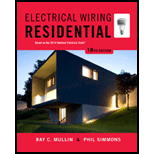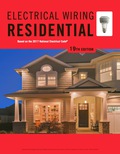
Based on the total estimated load calculations, what is the current draw on the Study/Bedroom circuit? __________________________________________________________
Calculate the current drawn on the Study/Bedroom circuit based on the total estimated load calculations.
Answer to Problem 1R
The current draw on the Study/Bedroom circuit based on the total estimated load calculations is 9.4 amperes.
Explanation of Solution
Formula used:
Write the general expression to calculate the VOLT-AMPERES for single-phase.
Here,
E is the supply voltage, and
I is the current.
Rearrange the equation (1) to find the current I in amperes.
Calculation:
Refer to Table 14-1 in the textbook.
The total estimated load in VA for the Study/Bedroom outlet count in Circuit A21 is 1125 VA.
The single-phase supply voltage (E) is 120 V.
Substitute 1125 VA for VOLT-AMPERES and 120 V for E in equation (2) to find the current I in amperes.
Conclusion:
Thus, the current draw on the Study/Bedroom circuit based on the total estimated load calculations is 9.4 amperes.
Want to see more full solutions like this?
Chapter 14 Solutions
Electrical Wiring Residential
Additional Engineering Textbook Solutions
Concepts Of Programming Languages
Automotive Technology: Principles, Diagnosis, And Service (6th Edition) (halderman Automotive Series)
Web Development and Design Foundations with HTML5 (8th Edition)
Starting Out With Visual Basic (8th Edition)
SURVEY OF OPERATING SYSTEMS
Starting Out with Java: From Control Structures through Objects (7th Edition) (What's New in Computer Science)
- i need help with this question i tried by myself and so i am uploadding the question to be quided with step by step solution and please do not use chat gpt i am trying to learn thank you. i only need help with the second question pleasearrow_forwardPlease provide explaination and workings.arrow_forwardDon't use ai to answer I will report you answer..arrow_forward
- Don't use ai to answer I will report you answerarrow_forward3) Find the valve of V using the Thevenin Equivalent Circuit and then determine if the 8 ohm resistor allows maximum power transfer. If not, then what value should the 8 ohm resist or be changed to for maximum power transfer? ZA 360 Am 6t + 22V V 3402 22 62 Mw marrow_forwardFind the valve of the voltage Vx using the THEVENIN 2) equivalent circuit and redo the problem with the NORTON equivalent circuit. Show both the flavinen and Norton Circuits DAY ww 1 23 www + 4444 5 63arrow_forward
 EBK ELECTRICAL WIRING RESIDENTIALElectrical EngineeringISBN:9781337516549Author:SimmonsPublisher:CENGAGE LEARNING - CONSIGNMENT
EBK ELECTRICAL WIRING RESIDENTIALElectrical EngineeringISBN:9781337516549Author:SimmonsPublisher:CENGAGE LEARNING - CONSIGNMENT
